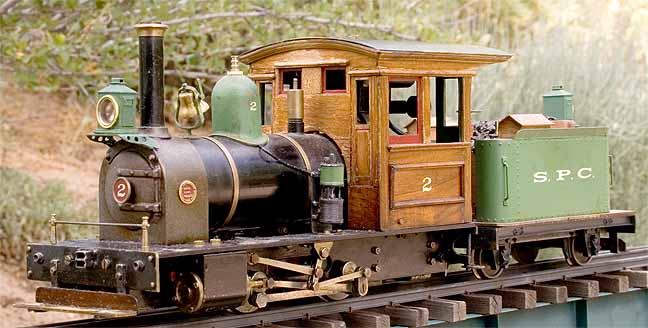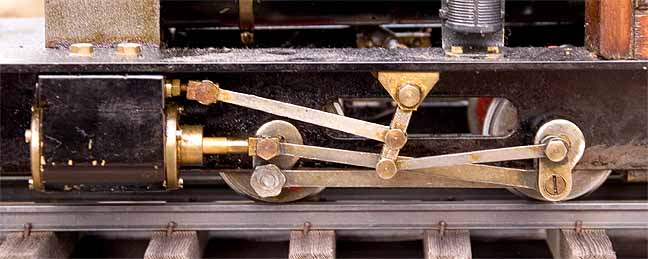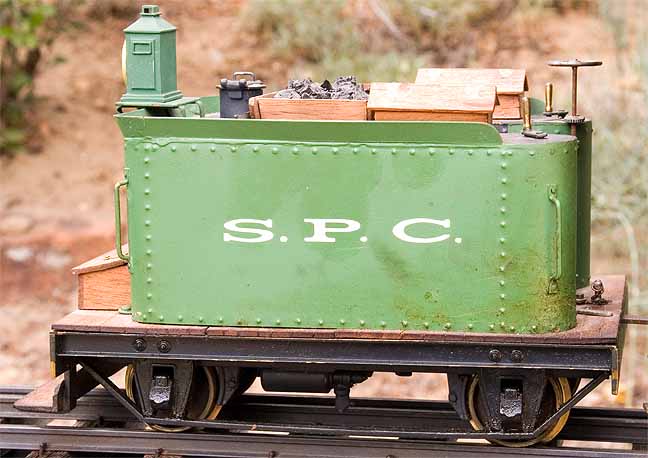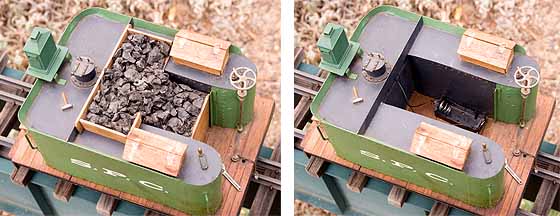
Back to Loco of the Month homepage
Back to Sidestreet Bannerworks
.
August 2008
Grover Devine's SPC No. 2
by Marc Horovitz

Grover Devine was one of the pioneers of modern-day garden railroading in the US. He lived in Hayward, California, and he modeled the South Pacific Coast (SPC) Railroad, a successful, narrow-gauge line in California. Although he was a firefighter by trade, he was something of a renaissance man, with diverse interests that included astronomy and building (and playing) harpsichords.
Grover’s railway lived in his relatively small backyard. The line was a simple dog-bone-ish loop with a small yard and engine facility. Because of the steeply sloping land, part of the track was at ground level and part was elevated on benchwork. Grover handlaid all of the track with aluminum rail. He also scratchbuilt all of his rolling stock and structures. Back in the late 1980s, there was little commercially available, especially for modelers of the South Pacific Coast. His town was wonderful -- highly detailed and full of character. I particularly liked his Venus de Milo Arms hotel. Grover's railroad was featured in the March-April 1988 issue of Garden Railways magazine.
Grover's first live-steam locomotive was a Merlin 0-4-0 British tank engine. This he extensively modified to resemble an American engine. American style, live-steam locomotives were virtually unheard of at that time. Grover made a new stack, added a headlight and other details, and made a beautiful new cab for the engine, constructed of brass and covered with walnut veneer. He also scratchbuilt a four-wheel tender for it. Although it didn't resemble any particular SPC locomotive, it certainly looked American.
Sadly, Grover passed away after a long battle with cancer, ironically during the 1993 Garden Railway Convention in the Bay Area. He was to have been on the tour and had even planned a barbecue for friends during the show. He has been much missed since then. Grover left this engine to me when he passed on.
The model
The locomotive, which is mechanically original, is typical of Merlin's offerings from this era. It is an 0-4-0 with regaugeable wheels. Pistons are double acting, controlled by piston valves. Reversing is accomplished by a rotary valve between the cylinders, beneath the boiler. This is actuated by a lever connected to a single servo in the cab. The locomotive is radio controlled, with the R/C gear residing in the cab. Four AA batteries are carried under the cab, between the frames. The on/off switch is also inside the cab.
The boiler is a standard, single flue, gas-fired unit. It is fitted with a safety valve and pressure gauge, but no throttle, as the rotary valve acts as both throttle and reverser. A large, square displacement lubricator sits in the right side of the cab. The gas tank is concealed in the roof of the cab, and is filled through a valve in the roof. A gas-control valve can be accessed through the left cab window.
The four-wheel tender has a brass tank that sits on a wood deck. It was fully detailed and painted, although some of the minor details have disappeared through the years. A working headlight, matching the locomotive's, is mounted on the rear of the tender. Together, the loco and tender look just right.
The run
As far as I know, this locomotive had not been run since Grover passed away. I checked it out and all seemed good, although there was quite a bit of slop in the rods, evidence of a life well lived. The wheels moved freely, though, and all else looked OK, so I prepared the engine for its run in the usual way.
The weather in Denver for this run was blistering -- hovering around 104 degrees in a record-setting hot spell. I opened the gas valve and held a lit match to the stack. The fire flashed back immediately. Pressure came up in a few minutes and I moved the servo into forward gear. The engine lurched for a few seconds while the cylinders warmed, then it took off.
All in all, the locomotive performed beautifully. It ran well in both directions. Fine control was a little problematic, since there was no proper throttle, but performance was all that could be expected, given the engine's mechanics. The safety was popping nearly all the time, despite my best efforts to throttle the gas down as low as possible.
The run lasted perhaps 25 minutes without complaint, when the gas was exhausted. Thinking about its probable previous run, 15 years earlier, on Grover's SPC made me a little sad, but it is nice to know that his railway and memory live on in this locomotive.
|
|
|
| Builder | Merlin Locomotive Works (England) / Grover Devine (California) |
| Date built | 1986 |
| Gauge | 45 |
| Scale | 1:22.5 |
| Boiler | Single flue |
| Fittings | Safety valve, pressure gauge |
| Fuel | Butane |
| Blow-off pressure | 45 psi |
| Cylinders | Two, double-acting piston-valve |
| Reversing gear | Rotary valve |
| Lubricator | Displacement |
| Weight | 8 lbs. (loco and tender) |
| Dimensions | Length (loco and tender), 16-1/2" over end beams; width, 4"; height over stack, 6" |



Above: The square lubricator is accessible through the right-hand cab door. The radio receiver can be seen above.






Below: The light on the tender works. A battery box is concealed beneath the coal load.



Back to Loco of the Month home page
Back to Sidestreet Bannerworks home page
This page and its contents
Copyright Sidestreet Bannerworks, 2008
.